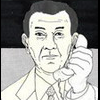Basically when you shine light on a photoactive molecule it activates. Just add those photoreactive groups to LSD then brightly illuminate a cubic centimeter at a time of a human brain to see how as well as where it works. Further if keeping it active goes with active photons the computer could detect when the experience was going happily, thus giving the person the ability to immediately change or leave their trip with different photon activation levels, If a few hundred micrograms is sufficient at an entire body then perhaps just 1 or 2 micrograms at a specific brain area would be effective
Now some of you might say, sounds like a highly personalized always pleasant psychedelic could we perhaps also use photocatalytic neurotransmitters to actually map out the entire brain. Just turn on dopamine, serotonin, or epinepherine at someplace pleasant like the nucleus accumbens (pleasure center) to see what each of these different neurotransmitters contributed to experience. This is actually where LSD apears to have further utility, it is possible that a twentieth of a microgram could activate a tiny area of brain to do mapping. (3 ug per 3000cc brain is a thousandth of a microgram per cubic centimeter)
Now the nootropics person might suddenly say "you know, affecting the reward centers of the brain with photonically activated neurotransmitters gives the capacity to superreinforce as well as reinforce with chronological precision right at the learned stimulus. This creates a superlearning drug
A very great benefit may be photocatalytic anesthesia, whole body anesthesia is sometimes linked to less than optimal outcomes. Thus a photoactivated anesthetic at specific brain areas spares most of the nervous system from risk while fully anesthetizing a person. Making general anesthesia vastly less risky also provides higher standard of practice as well as financial stimulus to the creation of photocatalytic drugs
Persons who find the existence to p zombie continuum of interest could find which neurotransmitters at precisely which brain area gave them an order of magnitude greater belief that they actually exist. Lighting this brain area up with photocatalytic neurotransmitters gives extreme validity of being while kindly using near zero community resources. Just hook up Stalin up to one of these, He thinks he matters so much more there than at society. Crummy person problem solved.
Well what do these photoactive molecules actually look like
At the article titled Evaluation of porphyrin C analogues for photodynamic therapy of cerebral glioma http://www.ncbi.nlm....les/PMC2074451/ the researchers created light responsive porphrin variants that crossed the blood brain barrier as well At a drug dose of 10 mg porphyrin 7 kg-1 body weight and laser doses of up to 400 J cm-2 light at 627.8 nm. Note that photocatalytic LSD may activate neuromicroregions at doses numerous orders of magnitude tinier reducing physiological risk.
also at Photopharmacology: toward a controllable physiological nitrosyl delivery system
lanthanides that release Nitrosyl with light are described Pleasantly some lanthanides are neurobeneficial
more published photocatalytic drug systems
Glycosylated cationic porphyrins
Dinuclear Ruthenium Complexes
Photoactive Liposomes UV-induced drug release from photoactive REV sensitized by suprofen
My approach to creating a photoactive neurodrug would be to use porphirin with the neurobeneficial lanthanide Ce at the core then attach neuroactive chemicals from neurotransmitters to LSD or DOI at the perimeter, perhaps with a chalcone linker to create drugs that were neurobeneficial even if unilluminated as a result of the lanthanide.
I also like the nonporphirin carotenoid liked to a zwitterion chalcone system to create a precisely tunable charge migration with light from the carotenoid zwitterion combo. (thought of here) Some zwitterions are known physiomild or physiobeneficial like phosphatidylserine as well as amino acids. The thingy is getting them balaced well with an active carotenoid so there is actually charge shift to different functional groups with light.
Basically the carotenoid is the antenna, shifting the zwitterion charge, permitting the functional group to be active. Ive read that chalcones are also very sensitive to environmental shifts as well.
http://www.apam.colu...6-salk-chan.pdf
There is an entire journal of photobiology, also a number of photocatalytic anticancer drugs have been FDA approved
Edited by treonsverdery, 10 January 2012 - 11:59 PM.














































